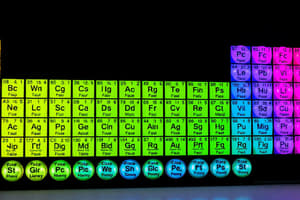Podcast
Questions and Answers
What is the purpose of arranging elements in the periodic table?
What is the purpose of arranging elements in the periodic table?
- To show their chemical and physical properties (correct)
- To display their symbols and names
- To list them based on their atomic mass
- To arrange them alphabetically
What are the elements in the far right of the periodic table called?
What are the elements in the far right of the periodic table called?
- Transition metals
- Alkaline earth metals
- Alkali metals
- Noble gases (correct)
How many different kinds of atoms are known to exist?
How many different kinds of atoms are known to exist?
- 124
- 106 (correct)
- 118
- 92
What is the definition of an atom?
What is the definition of an atom?
How are the elements in each group of the periodic table characterized?
How are the elements in each group of the periodic table characterized?
How are elements classified based on their physical properties?
How are elements classified based on their physical properties?
The periodic table arranges the elements depending on their physical properties only.
The periodic table arranges the elements depending on their physical properties only.
The symbols of elements are made up of one or two letters taken from the name of the element.
The symbols of elements are made up of one or two letters taken from the name of the element.
The elements in the far right of the periodic table are called the transition metals.
The elements in the far right of the periodic table are called the transition metals.
Elements that can be hammered into sheets, drawn out into wire, and are good conductors of heat and electricity are classed as nonmetals.
Elements that can be hammered into sheets, drawn out into wire, and are good conductors of heat and electricity are classed as nonmetals.
All the members of a group in the periodic table have similar physical properties.
All the members of a group in the periodic table have similar physical properties.
106 different kinds of atoms are known to exist.
106 different kinds of atoms are known to exist.
Match the following with their classification based on physical properties:
Match the following with their classification based on physical properties:
Match the following with their group in the periodic table:
Match the following with their group in the periodic table:
Match the following with their description in the periodic table:
Match the following with their description in the periodic table:
Match the following with their representation in the periodic table:
Match the following with their representation in the periodic table:
Match the following with their symbol and name representation:
Match the following with their symbol and name representation:
Flashcards are hidden until you start studying



